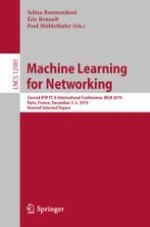This book constitutes the thoroughly refereed proceedings of the Second International Conference on Machine Learning for Networking, MLN 2019, held in Paris, France, in December 2019. The 26 revised full papers included in the volume were carefully reviewed and selected from 75 submissions. They present and discuss new trends in deep and reinforcement learning, patternrecognition and classi cation for networks, machine learning for network slicingoptimization, 5G system, user behavior prediction, multimedia, IoT, securityand protection, optimization and new innovative machine learning methods, performanceanalysis of machine learning algorithms, experimental evaluations ofmachine learning, data mining in heterogeneous networks, distributed and decentralizedmachine learning algorithms, intelligent cloud-support communications,ressource allocation, energy-aware communications, software de ned networks,cooperative networks, positioning and navigation systems, wireless communications,wireless sensor networks, underwater sensor networks.
